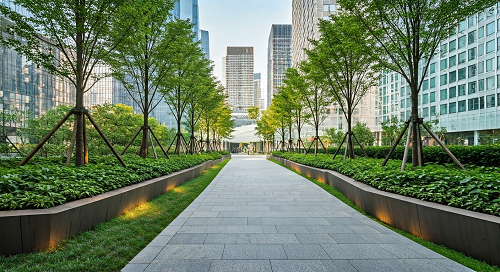Key Highlights
- Brisbane landscape architects are revolutionising outdoor spaces with innovative design approaches.
- Sustainable and eco-friendly practices are taking center stage this 2025.
- Advanced technologies, like AI and drones, are redefining landscape design projects.
- Climate-resilient landscapes are becoming critical as the planet faces environmental challenges.
- Health and wellness-focused outdoor spaces are gaining momentum, contributing to mental and physical well-being.
- Urban rewilding promotes biodiversity while connecting city dwellers to nature.
Introduction
Brisbane is quickly becoming a centre for new ideas in boutique landscape design. This is thanks to its skilled architects and designers. The city is full of energy, and industry professionals are using eco-friendly practices to create beautiful outdoor areas. A firm like Marchese Partners is expertly combining usefulness and beauty. Whether you want modern greenery or refreshed public spaces, Brisbane's wealth of experience guarantees an exciting future for landscape design.
Leading Trends in Landscape Architecture this 2025
The landscape design scene this 2025 features a great mix of sustainability, technology, and community input. Trends like regenerative designs and biophilic spaces are improving city life. At the same time, public areas that serve multiple purposes meet the needs of modern living.
In Brisbane, businesses are leading these new ideas. They are making sure their designs are friendly to the environment and can adjust to climate issues. Spaces that focus on health and urban rewilding show how landscape designers and architects are changing their priorities. They strive to balance usefulness and beauty when changing these areas. Brisbane architecture firms are at the forefront of this movement, blending innovative design with ecological responsibility to shape a more livable and resilient city.
Sustainable and Eco-friendly Design Practices
Sustainable landscape design is now a must for 2025, not just a trend. Architects in Brisbane are using eco-friendly methods to save water, recycle materials, and protect nature. These actions create beautiful and useful outdoor spaces for both urban and home needs.
A great example includes using drought-resistant plants and edible gardens that focus on both environmental and practical needs. Sustainable landscape designs now range from rooftop gardens to permeable pavements. They aim to lessen environmental impacts while looking good.
Brisbane landscaping firms, such as Marchese Partners, lead in these positive changes, particularly in Brisbane, through their extensive experience and expertise in horticulture. Their work focuses on systems that work well with nature and innovative garden design. With climate change affecting us, sustainable methods will keep shaping landscape design in the future.
Integration of Advanced Technology in Landscape Projects
Advanced technology is changing landscape architecture in interesting ways. This 2025, the new ideas will be widely used in Brisbane’s design scene. AI and modeling software help architects predict outcomes and use space better when designing.
Drone technology plays a big role, too. It maps sites accurately and tracks progress, saving both time and resources. Architects also work with smart irrigation systems. This cuts down on water waste while keeping plants healthy in eco-friendly landscapes.
Other important technologies in landscape design are:
- 3D modeling: It helps visualise spaces before building.
- GIS mapping tools: They analyse environmental factors, leading to designs that can handle climate challenges.
- Automated lighting solutions: They create energy-efficient outdoor areas.
These advancements show Brisbane’s dedication to modern and high-tech landscape projects.
Climate-Resilient Landscaping
Climate-resilient landscaping is key for future designs in Brisbane. This helps outdoor spaces deal with environmental challenges. Architects are using native plants and smart drainage systems to fight extreme weather like droughts and storms.
Xeriscaping is a practice that lowers the need for water while keeping things looking good. Brisbane architecture firms suggest planting shade trees and using reflective materials. This helps to reduce heat in urban areas. Their plans focus on being strong and adaptable, whether in cities or suburbs.
A firm like Marchese Partners creates layouts that manage stormwater well and lessen flooding issues. This active approach makes sure that landscape designs not only survive but also succeed in Brisbane's changing climate.
Regenerative Landscape Design
Regenerative landscape design goes further than just being sustainable. It helps restore ecosystems. Architects in Brisbane are using this idea to create outdoor spaces that support nature and promote ecological health.
Their projects aim at regenerating soil, planting native plants, and building carbon sinks with green walls and urban forests. Edible gardens that help communities and the environment are becoming popular among locals.
This method makes sure that landscapes not only save resources but also help to restore them. Innovative architects in Brisbane are combining regenerative strategies, setting new standards in landscape design.
Health and Wellness-Focused Spaces
Designing places that support health and wellness is very important for Brisbane’s landscape architects. This 2025, they are changing urban areas to make them more inviting. These spaces encourage people to be outside, whether it's for yoga, meditation, or simply going for a walk in peaceful areas close to nature.
Features like therapeutic gardens are becoming popular. These gardens include plant types that help mental health. Brisbane architects often add water features to these gardens. This makes the area peaceful and improves air quality too. From green parks to home courtyards, wellness is a key part of modern design plans.
Health-centred designs help bring people closer to nature and reduce stress. This makes them very valuable in busy city areas. Brisbane is moving forward as a leader in landscape architecture focused on wellness.
Biophilic Design Integration
Biophilic design brings natural elements into buildings. This makes it easier for people to connect with nature through careful choices in architecture. Architects in Brisbane are leading the way with biophilic solutions. These designs improve both mental and physical health and make spaces look beautiful.
Some examples of biophilic design are living walls, lots of natural light, and plants placed carefully in public and private areas. Designers in Brisbane also work for better air flow and energy saving, using sustainable materials based on these ideas.
Biophilic integration changes areas by mixing indoor and outdoor spaces smoothly. It is set to be a key part of architectural trends this 2025.
Multifunctional Public Spaces
Multifunctional public spaces mix usefulness with beauty. They let communities enjoy outdoor areas in many ways. From the squares in Brisbane to new park designs, these places meet different needs. They become centres for fun, leisure, and activities.
Architects are adding smart seating, water features, and green areas to Brisbane’s public spaces. This makes locations perfect for festivals, social events, and personal relaxation.
Having many functions is important for meeting city's needs. It helps public spaces serve different purposes while also looking good.
Rewilding Urban Areas
Urban rewilding helps bring nature back to busy cities and connects people with the environment. In Brisbane, landscape architects change unused areas into homes for plants and animals. This work makes the city's ecosystem better.
Some examples are green pathways for local wildlife, gardens that attract pollinators, and biodiversity units on rooftops. Local businesses focus on turning empty lots into nature-filled spaces that delight the community.
Rewilding adds to city life with solutions for nature. Architects in Brisbane support conservation and biodiversity by working on large landscaping projects.
Low-Maintenance, High-Impact Materials
Brisbane landscape experts focus on using materials that require little maintenance but have a significant impact. They choose options like recycled concrete, composite decking, and durable stone that last a long time and still look good.
These materials need less care, making them great for busy city people and also supporting environmentally friendly practices. Eye-catching designs can produce stunning results, whether in private backyards or public parks.
By mixing function with beauty, Brisbane companies are changing how materials are used in landscape design.
Community-Led and Culturally Inclusive Design
Brisbane architects use community-focused methods and cultural inclusivity in their designs. This helps them serve the diverse population better. Their collaborative projects let locals share what they need and want, making sure spaces show shared values.
Many Brisbane firms are now using native plants and important cultural items in their designs. These choices connect with the communities, helping to build a sense of belonging and pride.
By focusing on inclusive designs and working closely with clients, Brisbane architects are taking the lead in raising cultural awareness through sustainable design.
Conclusion
In conclusion, the landscape architecture industry in Brisbane is ready for a big change this 2025. By using sustainable methods, smarter technologies, and focusing on community needs, firms can build spaces that improve the environment and support health and well-being. The highlighted trends show the need for new ideas like climate-resilient designs, biophilic features, and public areas that serve our changing society. As we move ahead, landscape architects need to be flexible and listen to these trends. This way, their designs will help the urban ecosystem and build a strong community. Stay ahead and think about how these new practices can shape your future landscape projects.
Frequently Asked Questions
What is the difference between sustainable and regenerative landscape design?
Sustainable landscape design aims to reduce damage to the environment by using friendly practices. Regenerative design, on the other hand, works to renew and improve ecosystems. This means regenerative methods do more than just save what we have; they help create lasting health for nature. Both types of care are about being eco-friendly, but they differ in how much they help.
How is technology transforming landscape architecture this 2025?
Technology is changing landscape architecture this 2025 with tools like AI and drones. These tools make work faster and more creative. Smart software allows architects to create precise design models. Also, smart systems help save water and energy. Firms in Brisbane are using these new methods to create projects that are ready for the future.
Why is community involvement important in modern landscape projects?
Community involvement makes sure that landscape projects meet the needs and culture of the people. It helps design teams work together with those who live in the area, creating spaces that feel right for everyone. Architects in Brisbane focus on inclusivity to create designs that matter to their clients and improve urban spaces.


































